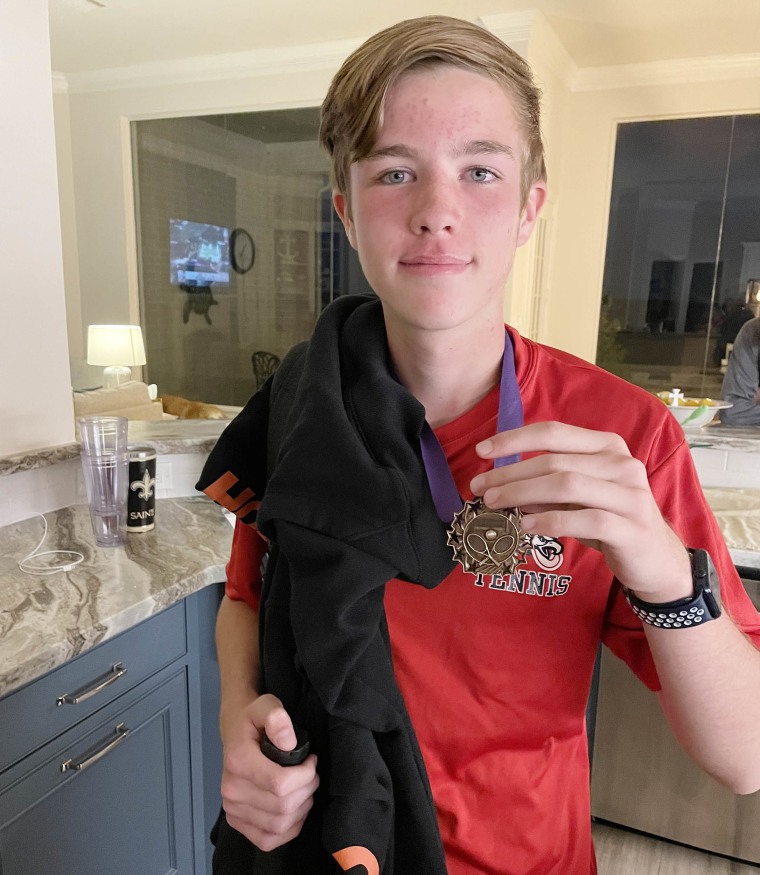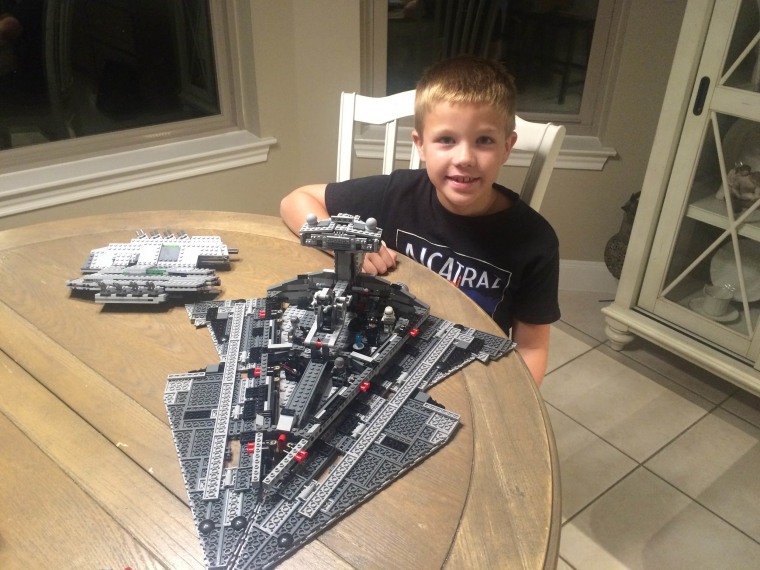When Cole Smith was 9 years old, he noticed that any time he looked at something, he saw double.
“I’d see two of it, and then I’d have to blink until (I could) align the two images. I was just fatigued,” the now-16-year-old from Houston tells TODAY.com. “I thought I needed glasses.”
His mom, Kendra Smith, agreed, so she scheduled an eye exam for him. But they soon learned something else was causing Cole’s vision troubles. He had a brain tumor.
“(The doctor said) it’s not his vision. It’s neurological,” Smith tells TODAY.com. “He showed us the MRI. Right away there was tremendous fear.”
Vision problems reveal tumor
When Cole first told his parents about his vision problems, they wondered if needed an eyeglasses prescription.
“Cole has always been real healthy and (on a) normal development curve,” Smith says. “There was no reason to think that there was anything crazy going on.”
But the eye doctor realized quickly that something else was causing his double vision.
“They decided to look more, and they saw that one of my optic nerves was swollen,” Cole says. “They recommended that we go to a neuro-ophthalmologist.”
The wait to see a neuro-ophthalmologist was months long, so the eye doctor encouraged the family to go to the emergency room for faster treatment.
“(The eye doctor) was like, ‘We need to do these tests,’” Smith says. “I remember I texted my husband, and we were like, ‘We’ll just go get a second opinion.’”
At the emergency room, doctors ordered an ultrasound of the optic nerve and MRI of Cole’s brain. Cole didn’t have “traditional” tumor signs such as vomiting or headaches, Smith says. But emergency room doctors noticed that his eyes weren’t pointing in the proper direction, and the images revealed what was wrong.
“They clearly saw a tumor,” Cole says.
The diagnosis of a brain tumor felt shocking. When they told the family, Smith “crumpled.”
“In walked four white coats that said ‘neurosurgery,’” she recalls. “I knew it wasn’t good.”
Doctors wanted to biopsy the tumor, a midbrain infiltrating glioma, to understand its stage and create a hole in Cole’s skull to drain some spinal fluid that accumulated, a procedure called a ventriculostomy. The tumor was nestled in the middle of his brain at the top of his spinal cord, and it pushed his spinal cord down, which caused the spinal fluid to collect. But the surgery had mixed results: The biopsy failed, and the ventriculostomy later closed. Cole later had this procedure successfully repeated.
“If they would have done surgery to try and remove it, it was right up against his spinal cord,” Smith says. "They were never going to actually get every last cell."
Doctors treated Cole with proton radiation five days a week for six weeks. He had to wear a mash mask with a mouthpiece to undergo the radiation in the proper location each time. The mask was also screwed into a table, limiting his ability to move during treatment.

“It’s a bit claustrophobic whenever it gets screwed down. It’s kind of like you’re locked in there,” Cole says. “That’s overwhelming.” As follow up, he received MRIs and blood tests to make sure the tumor was stable.
“The gamma radiation, it swelled the tumor, so we wanted to make sure that it ended up going back down,” he says.
Midbrain infiltrating glioma
A glioma is a tumor of the glial cells, which are located in the nervous system and support the neurons and overall brain function, Dr. Holly Lindsay, a pediatric neuro-oncologist at Texas Children’s, tells TODAY.com. “The most common type of tumor in the brain and spinal cord of pediatric patients is tumors of the glia cells.”
Brain and spinal cord cancers are the second most common type of cancers in pediatric patients after leukemia.
“Despite not being No. 1 they are, unfortunately, the No. 1 cause of cancer-related death in kids,” Lindsay says. “In pediatrics, the leading cause of medical death is cancer.”
While Cole experienced double vision that signaled he had a brain tumor, the symptoms of the tumor often vary based on where the tumor grows. The most common symptoms of a brain tumor are:
- Recurrent headaches
- Vomiting
- Blurry vision
“But there’s numerous reasons that these could happen in the pediatric population that aren’t a brain tumor,” Lindsay says. “Any concerns that you have related to these kind of changes in what we call mental status, or (if) you think your child is just not acting correctly, bring that to your pediatrician.”
In most cases, she says, something like frequent headaches have a more innocent cause, such as a child who says up too late staring at screens or one who needs to drink more water.
“There are things pediatricians can do to parse out, 'Is this just the normal tension headache because the child is 14 and stressed out? Or is that something of a concern?'” Lindsay says.
Because doctors weren't able to determine the stage of Cole's tumor, it was considered non-gradable, and many children with this type of growth receive the same very targeted type of radiation that he did.
“The benefit of proton radiation is that it’s very focused on the tumor,” Lindsay says. “There’s less spill of radiation to other parts of the brain we’re not trying to radiate.”
That means Cole was less likely to experience long-term effects of radiation, which can include worsened emotional function, reduced IQ, poorer academic performance or impaired hormone production. Pediatric oncologists have to navigate the challenge of treating cancer while trying to preserve a child’s long-term health.
“We want to improve survival as much as possible, which typically means being as aggressive as possible with therapy,” Lindsay says. “But what we don’t want is to leave our survivors so impaired that their rest of their lives, their quality of life is so poor.”

Long-term pediatric cancer survivor
Cole was diagnosed with cancer in 2016 and completed treatment in 2017, so he's been cancer-free for over five years, the traditional measurement used to consider a patient safe from recurrence.
“We expect that the radiation has prevented it from further growth,” Lindsay says. “Most of the time if you make it five years like this, the tumor will not regrow.”
Cole attends a clinic for long-term survivors at Texas Children's, where a medical team monitors him for potential negative effects of the radiation treatment, such as hormone impairment, skin cancer and reduced heart function. But the clinic also offers social workers and support groups to help children process their experience.
Recently, Cole has been thriving. During freshman and sophomore year, he played tennis, but he’s trying out chess now. He enjoys going to the gym, reading and watching TV. From his experience with cancer, the family learned how to better appreciate life.
“We laughed at some of the smallest things,” Smith recalls. “We were enjoying all of those little moments, not knowing what was ahead.”